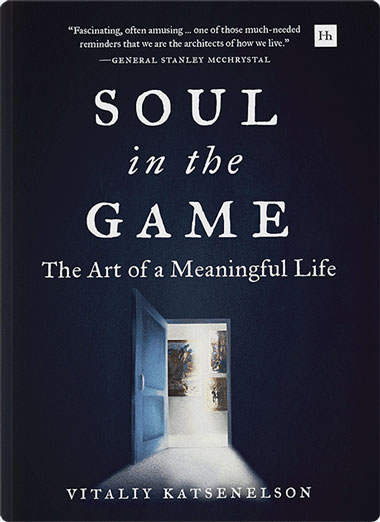“Fascinating, often amusing… one of those much-needed reminders that we are the architects of how we live.”
General Stanley McChrystal
Author, Risk, A User’s Guide
“One day you ordered a Happy Meal for the last time and you didn’t even know it.” – McDonalds.
No, this McDonalds was not an ancient Roman contemporary of Seneca. This was a tweet by the McDonalds Corporation that appeared in my browser right when I sat down to write about this topic. It perfectly summarizes a type of visualization that William Irvine, in A Guide to the Good Life, called “Last Time.”
For everything we do, there will be a last time. Yes, there will be a last time we’ll take a breath, but that is not the focus of this exercise. There was a last time I changed Mia Sarah’s diaper (though my wife will insist I did not change it enough); there was a last time I drove Jonah to school; there was a last time Hannah needed me to lull her to sleep with a story; there was a last time I saw my mother; and yes, there will be a last time I buy a McFlurry at McDonalds (I’m not a Happy Meal-type person).
The Last Time negative visualization is there to ignite the appreciation that time, though infinite, is given to us in limited amounts to spend. This negative visualization of the finite nature of the personal time granted to us can help us increase the value of the present moment.
“It is not that we have a short time to live, but that we waste a lot of it. Life is long enough, and a sufficiently generous amount has been given to us for the highest achievements if it were all well invested.” This excerpt from Seneca’s On Shortness of Life is very appropriate here, but here is the punchline:
“But when it is wasted in heedless luxury and spent on no good activity, we are forced at last by death’s final constraint to realize that it has passed away before we knew it was passing. So it is: We are not given a short life, but we make it short, and we are not ill-supplied but wasteful of it…
Life is long if you know how to use it.”
We, yours truly included, are often not here, not in the present; we are daydreaming away in the past or in the future, while time does what time does, turning future into past. As the great Freddy Mercury put it, “Time waits for no one.”
When we go to graduations or funerals, we recognize the shortness of life, we contemplate it on the drive home, and then we forget about it.
I am writing this on Wednesday before Thanksgiving, at 5 a.m. We are in
Vail for a few days of skiing. In about two hours my kids will wake up; my wife will make breakfast; she’ll worry that the kids are underdressed for the weather (that is what mothers do), and we’ll get ready to go skiing.
I’ll put my laptop away and not think about this book till tomorrow morning. I’ll focus on inhaling life with my kids – helping Mia Sarah (6) put her cute ski boots on, reminding Hannah (14) not to forget her gloves, and being in awe of Jonah (19) as he teaches Mia Sarah how to ski.
Some of the things I do today I may be doing for the last time. The kids will grow up. Mia Sarah will not need help with her ski boots. Though I doubt Hannah will stop forgetting and losing her ski gloves, at some point her husband will be the one reminding her. Mia Sarah will not need Jonah’s ski lesson, and Jonah will be teaching his own kids to ski.
Yes, there is something I’ll be doing today for the last time. I don’t know what it is and will only recognize it in hindsight. I want to be present for it. I need to keep reminding myself of this daily and not wait for funerals and graduations.
William Irvine writes: “By contemplating the impermanence of everything in the world, we are forced to recognize that every time we do something could be the last time we do it, and this recognition can invest the things we do with a significance and intensity that would otherwise be absent.”
I am not a big fan of religion (blame the Soviets for that), but religion did figure out daily repetitions. The Last Time visualization is a useful daily repetition (or prayer, if you like). Just remind yourself every morning that there is a good chance there is something you’ll be doing for the last time – the past is already past; the future lies forever in the future; we have only now.
Seneca puts it beautifully: “Let us prepare our minds as if we’d come to the very end of life. Let us postpone nothing. Let us balance life’s books each day. The one who puts the finishing touches on their life each day is never short of time.” Seneca’s Eastern counterpart, Confucius, appropriately pointed out five hundred years earlier: “We have two lives, and the second begins when we realize we only have one.”

Dubbed “the new Benjamin Graham” by Forbes, Vitaliy is the CEO of a value investing firm, author of several books, and a prolific writer on topics as diverse as investing, parenting, classical music, and self-improvement. You can read his articles at Investor.fm or listen to them on his podcast, The Intellectual Investor.
“Fascinating, often amusing… one of those much-needed reminders that we are the architects of how we live.”
General Stanley McChrystal
Author, Risk, A User’s Guide
“Soul in the Game is a beautiful way to search for the lost value of happiness, strength and health.”
Wim Hof
Author, The Wim Hof Method

“Vitaliy knows how to tell a story. This book reads like a conversation with Vitaliy: deep, insightful, inquisitive and civilized.”
Nassim Nicholas Taleb
Author, The Black Swan
“Vitaliy Katsenelson has been singled out by financial media for his brilliant investment strategies, but perhaps even more impressive are his philosophical writings.”
Carl Bernstein
Author, All the Presidents Man
Leave a review and send a link or a screenshot of the review to bonus@soulinthegame.net to receive 6 new pieces (35 pages of content!)